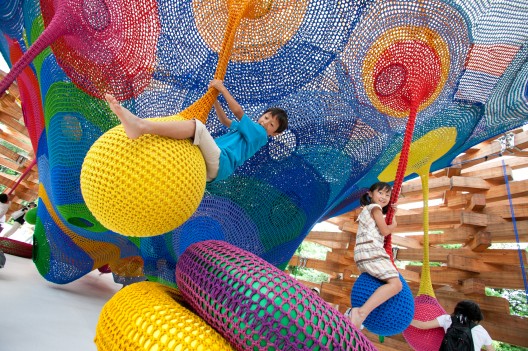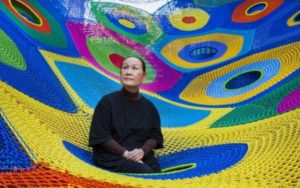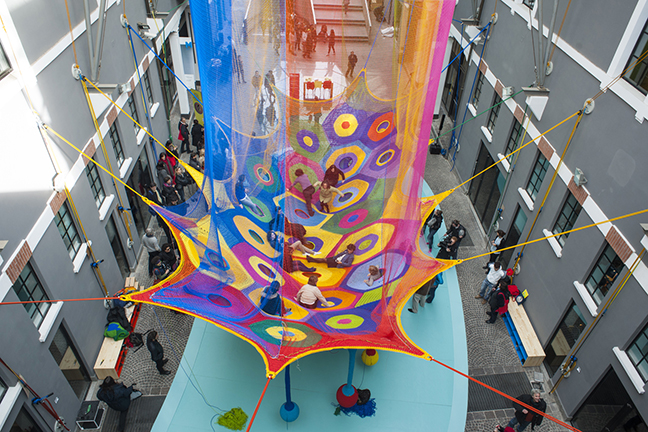 We started this 5-part series on improv artists doing needlework with yarn bombing – a form of street art whose primary purpose is to produce smiles. We end it with crocheted playgrounds – an in- or outdoor art whose purpose is to produce smiles by interacting with it.
We started this 5-part series on improv artists doing needlework with yarn bombing – a form of street art whose primary purpose is to produce smiles. We end it with crocheted playgrounds – an in- or outdoor art whose purpose is to produce smiles by interacting with it.
Toshiko Horiuchi MacAdam was born in Japan in 1940 and is currently based in Bridgetown, Nova Scotia, Canada, where she and her husband, Charles MacAdam run Interplay Design and Manufacturing. She has a master of fine arts degree from Cranbrook Academy of Art in Michigan, where she first began focusing on fiber and textile arts. But playgrounds for children came about by accident years later.
As she describes it, “One day I was exhibiting a 3-dimensional open-work textile sculpture I had created in collaboration with a friend. Some children came to the gallery and climbed into it. Suddenly the piece came to life. My eyes were opened. . . I realized I was in fact making works for children. It was an exciting moment for me.”
She notes, “Children learn through play, grow emotionally and imaginatively; they develop social skills, learn to cooperate, and gain wisdom about life. It is essential they use their bodies, challenge themselves, have fun, sweat and laugh with others.” Don’t you agree?
She put her skills to work, and has made these elaborate pieces mostly by hand because, “Each work is one-of-a-kind. As I work, the image takes shape in my mind’s eye. It is as if the image is telling my hands what to do – which is why it is difficult to use other people’s hands. When I am using my hands, my brain focuses, the image becomes clearer, technical solutions come to mind.” She uses a thick nylon rope that with proper maintenance creates playgrounds that can last for decades.
 Over the years, Ms. Horiuchi MacAdam and her husband have created “public art for kids” in Okinawa, in national, prefectural and municipal parks in Japan as well as Singapore Zoological Gardens, Moon River Art Park (Shanghai) and Gana Art Gallery’s JangHeung Art Park near Seoul, Korea.
Over the years, Ms. Horiuchi MacAdam and her husband have created “public art for kids” in Okinawa, in national, prefectural and municipal parks in Japan as well as Singapore Zoological Gardens, Moon River Art Park (Shanghai) and Gana Art Gallery’s JangHeung Art Park near Seoul, Korea.
While the playgrounds make up only a fraction of her exhibits, writing, and teaching, it is a legacy she is proud of. She notes, “It gives me joy to contribute my talent, my experience as an artist to those around me. My works are much loved by children.” Indeed they are – and by playful adults, too.
See more evidence here.
